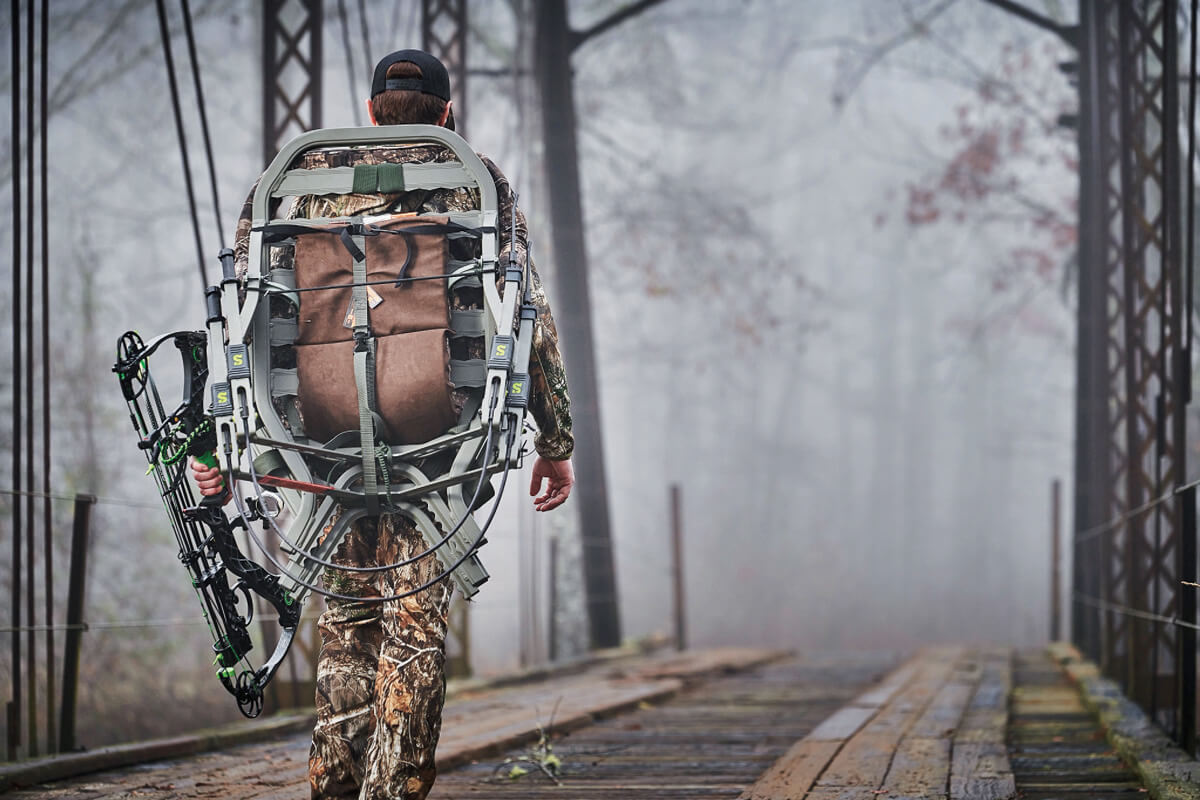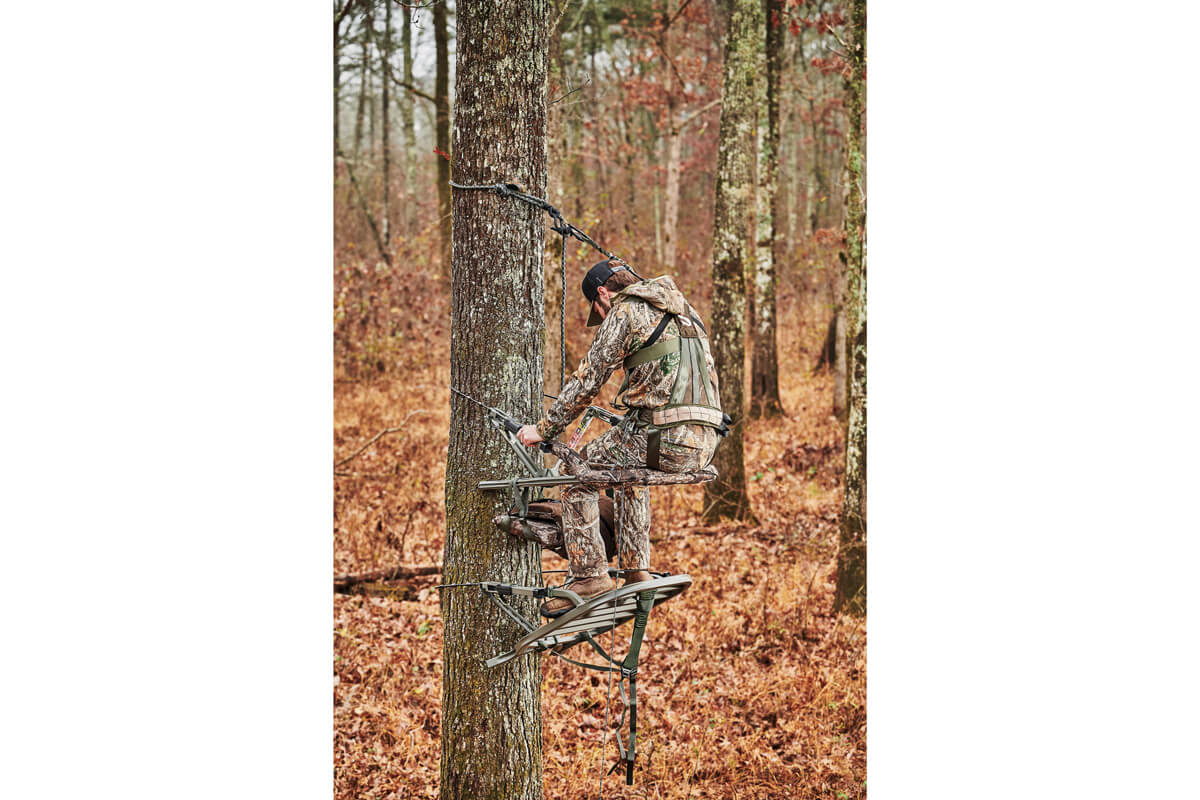
A climbing stand allows hunters to be mobile, change spots with ease, and hunt new stands in minutes. (Photos courtesy of Summit Treestands)
We had already hung a perfectly good ladder stand in the pasture corner, and hunting it would’ve been a hell of a lot easier than fiddling with a climbing stand in the dark. But it probably would’ve been a waste of time, too. It was early December. The leaves were gone. And the deer had been shot at for three months. I figured my chances of getting drawn were better if I hunted from the nosebleed section of the canopy, so I scaled 30 feet up a nearby poplar.
I’d gotten pictures of a tight, heavy 8-pointer with a palmated beam the previous morning. He ambled into view an hour after daybreak as if he’d reviewed the script the evening before. I drew as he closed the distance. At 15 yards he stopped to stare at the ladder stand. He was facing me almost head-on, so I held at the crease of his neck and shoulder and let fly. The arrow buried to the fletching, and the buck crashed 20 yards away.
If I had hunted the ladder stand, I don’t think I’d have killed that buck. Being mobile is a hot topic in deer hunting right now—and for good reason. Public-land hunting—where permanent stands frequently aren’t allowed—is also a hot topic. Besides that, the ability to act on recent scouting intel and set up quickly is one of the best ways to shoot a deer on public or private land, particularly when hunting feeding patterns early or late in the season.
So what’s the best way to be mobile? Tree saddles and ultralight hang-on stands are certainly trendy and work well if you’re comfortable using them. But for most bowhunters, I still say a climbing stand is the more practical choice. I’ve been using the same Summit Open Shot for more than a decade. I replaced the cables on it once, but otherwise, it’s just as it arrived in the box. When I need to set up somewhere new in a hurry, it works.
Some say climbers are too heavy and noisy, but that’s just not true. People are noisy. Metal clanks and pings are as easy to make against a climbing stick as a climbing stand. Scaling a tree with a climbing stand does indeed make sound—but one that’s not unlike a buck rubbing its antlers. I’ve “rattled in” enough deer with a climbing stand to suspect that it’s actually a pretty natural noise. I’m not saying it’s any sort of advantage, but it’s not something that causes me to lose sleep.
As for weight, my Open Shot—or a similar model like the Lone Wolf Assault climber—weighs about 15 pounds. The Lone Wolf Custom Gear D’Acquisto 2.0, a premium, ultralight hang-on with a comparably sized platform, plus four climbing sticks and straps, weighs a little over 21 pounds.
Speed counts, too. I hang 20 or more lock-ons with portable sticks each year and can do it quickly, sometimes in a single trip up the tree. But I can scale 20 feet in a climber in about half the time. Most hunters using a saddle or hang-on are also limited in hunting height by the number of climbing sticks they’re willing to carry. (And, yes, I have seen the single-stick method used by some saddle hunters; it’s cool, but also looks a little slow—and do not drop the stick.) With a climber, you can scurry up and hunt among the hoot owls if you so wish.
Time on the stand kills deer, and you can’t discount the importance of comfort. Tiny stands are handy, but bigger platforms and cushioned seats are more comfortable. Them’s the facts. I haven’t hunted out of a saddle enough to say definitively that a climber is more comfortable, but I know what my own two eyes seem to tell me.
With all that in mind, climbers are also comparatively cheap. For a Tethrd tree saddle, plus a platform and set of four Millennium M250 aluminum sticks, you’re looking at an out-the-door price of $734. For the Lone Wolf Custom Gear stand I mentioned and a matching set of four sticks, you’re looking at $1,049. Meanwhile, the Summit Open Shot is going for $340, and the Lone Wolf Assault is $400.
Hell, that alone is enough to convince the crowd of cheapskates I pal around with.
Picking Trees
Really, a climbing stand’s only drawback is that you need a fairly straight and clean tree trunk to climb, and in some areas of the country—Texas, Oklahoma, and the Western Plains come to mind—such trees are tough to find. But in most of the Midwest and, especially, throughout the East, there’s no shortage of climbable timber. In Kentucky and Tennessee, where I hunt the most, I don’t remember ever abandoning a hunting spot for lack of a suitable tree.

Ideal trees are about 16 inches in diameter, but anything from 13 to 25 inches, give or take, will work. Oaks, pines, poplars, and pignut hickories are good ones, since they grow tall and straight, and their rough bark provides a secure bite for the stand. I’ve scaled and killed deer from sycamore and beech trees, too, but their slick bark (especially that of the sycamore) makes it difficult for the stand to bite and hold the tree. Hunt from them cautiously. Obviously, you need a trunk that’s unencumbered by large limbs, but you can take care of small ones with a handsaw as you climb.
Look for the tree that’s unnoticed; for example, the most inconspicuous trunk in a group of four. Concealing foliage nearby also helps. Early in the season, I love to sit just above a leafy sapling that obscures a deer’s upward view. With a climber, you can move the platform up, down, or around the tree to find the best shooting lanes.
Most climbing stands have two parts: the hand climber/seat and the standing platform. They should be tethered together at all times. When I put my stand on a tree, I like to put the platform on a little tight, so that it’s pointed upwards at a 15- to 20-degree angle. Tree trunks get narrower as you ascend, and the idea is for the platform to level out when you settle in to hunt (some newer stands have built-in leveling systems). It goes without saying to wear a safety harness. I put my tether belt around the tree and slide it up as I climb and never allow it to get lower than eye level.
Bring two pull-up ropes—one for your bow or rifle and one for your pack—and stick two gear hangers in your pockets. Climb slowly, stay quiet, and get settled before pulling your gear into the tree. Be sure the seat is secured against the tree—most climbers come with a buckle strap to cinch it down—so that you don’t bump it and cause it to fall when standing for a shot. Then sit there all day, if you have the patience.
It’s no doubt quieter and more convenient just to sneak into a permanent stand. But a climbing stand has other perks, too. I particularly enjoy the ritual of climbing back down to take up a blood trail.











































